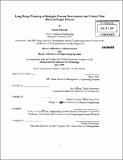Long range planning of biologics process development and clinical trial material supply process
Author(s)
Edwards, Emily (Emily Rose)
DownloadFull printable version (6.007Mb)
Other Contributors
Leaders for Global Operations Program.
Advisor
Roy Welsch and Charles Cooney.
Terms of use
Metadata
Show full item recordAbstract
This thesis investigates the feasibility of using a complex model with a Monte Carlo simulation model to forecast the financial, personnel, and manufacturing capacity resources needed for biologic drug development. Accurate forecasting is integral across industries in order to make strong longterm, strategic decisions and an area many companies struggle with. The resources required for the development of a biologic drug are especially hard to estimate due to the variability in the time and probability of success of each development phase. However, in the pharmaceutical industry getting products to market faster allows the company more time to recoup the substantial development investments before the patent expires and also potentially has a large impact on a company's market share. For these reasons, Novartis Biologics wanted to develop a simulation model to provide an objective opinion and assist them in their long-range planning. This thesis describes the design, development, and functionalities of the resultant model. During validation runs, the model demonstrated accuracy of greater than 90% when compared against historical data for headcount, number of campaigns, costs, and projects per year. In addition, the model contains Monte Carlo simulation capabilities to allow users to forecast variability and test the sensitivity of the results. This proves the model can be confidently used by project management, operations, and finance to predict their respective future resource needs.
Description
Thesis (M.B.A.)--Massachusetts Institute of Technology, Sloan School of Management; and, (S.M.)--Massachusetts Institute of Technology, Engineering Systems Division; in conjunction with the Leaders for Global Operations Program at MIT, 2011. Cataloged from PDF version of thesis. Includes bibliographical references (p. 50).
Date issued
2011Department
Leaders for Global Operations Program at MIT; Massachusetts Institute of Technology. Engineering Systems Division; Sloan School of ManagementPublisher
Massachusetts Institute of Technology
Keywords
Sloan School of Management., Engineering Systems Division., Leaders for Global Operations Program.